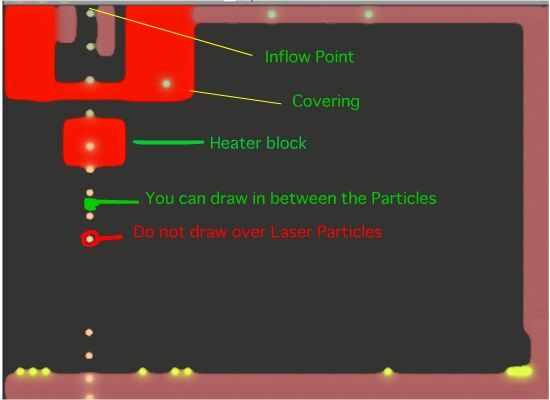A laser is an object that is one molecule wide, like a domino , and explodes when an object touches them, spreading itself over the playfield. Every laser includes inflow in its mixture. There are three types of lasers, melting lasers and exploding lasers. Melting lasers melt the objects that touch them, while exploding lasers use force. Another type of laser, the outflow-laser, uses outflow to destroy the target.
To create a laser, pick a laser recipe and draw a 1-particle thick but much longer line of particles (like a stack ). If it doesn't expand, try using the move tool to shake it around.
An example of a melting laser material is SUSHI . DIY is a high-powered exploding laser. KILO is an outflow-laser. Another powerful exploding laser is JHGI . It explodes and burns.
IFGHT is a versatile laser material, because it can be used vertically or horizontally.It is accelerated by the Tensile and Inflow properties. When it hits Elastic , For example, it pierces through the elastic and makes globs of burning gas.
Stationary lasers based on powder can be made by enabling "Powder" Inflow (SHIFT+P), and switching the Pouring Width to 1 particle wide. The next component is a Heater Block Directly under the thin stream of Powder . The next step is to change the Parameters of maxSpeed, and pouringVelocity, and If you want a more powerful laser, change the powderExplosionCoefficient, too. By raising the maxSpeed, the powder can pass through the Heater. By tweaking the shape/position of the heater, and the maxSpeed and/or the pouringVelocity variables, the powder can be made to pass through the heater in a straight line. If the powder passes through un-lit, make the heater a bit thicker. The powder should light, and pass through the heater, making straight beam of burning powder particles. Turn on Outflow.
NOTE: Place a wall at the bottom of the screen if Gravity is turned on, so that objects won't fall off of the screen. If the Laser beam is bouncing off of the "floor", adjust the Wall's size until the beam passes through the wall (floor)
Also: The beam is toggled on and off by SHIFT-P.
Extras: If you want you can make a covering around the laser with wall (so stray particles won't enter the laser). This is sometimes necessary, especially if the laser is very powerful, since it causes particles to accelerate rapidly. Also, you add decorations to the laser, as long as they don't interfere with the actual beam. Dots of powder CANNOT be covered (except by the heater block), but you can draw walls, etc between the dots of the beam and it will not affect the path of the particles.
All lasers use Inflow as a base, but you can add more materials to change their properties.
There are a few primary laser "types", listed before (melting, exploding, and outflow).
- Adding Heater will turn it into a melting laser, giving it the ability to melt and burn targets.
- Adding Outflow will turn it into an outflow laser, giving it the ability to absorb and destroy most targets.
- Exploding lasers are more open-ended, but should focus on getting as much force as possible out of the explosion.
Pure I creates a weak exploding laser, but to create more powerful exploding lasers, you should add more elements.
User can be added to any laser to allow you to explode it manually by pressing left or right arrow keys.
Gas can be added to any laser to allow it to be placed horizontally in a simulation with gravity.
